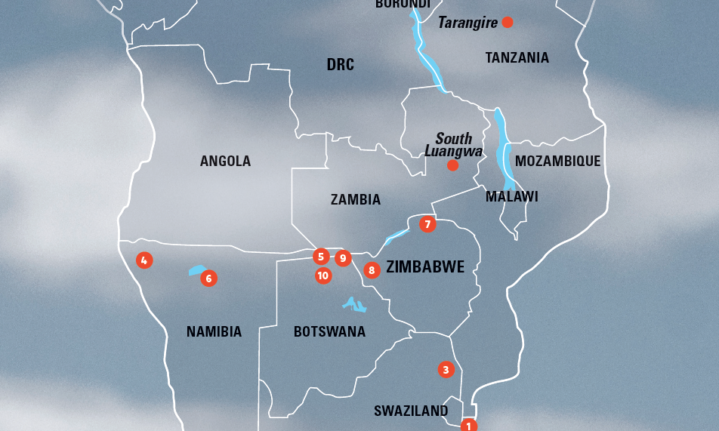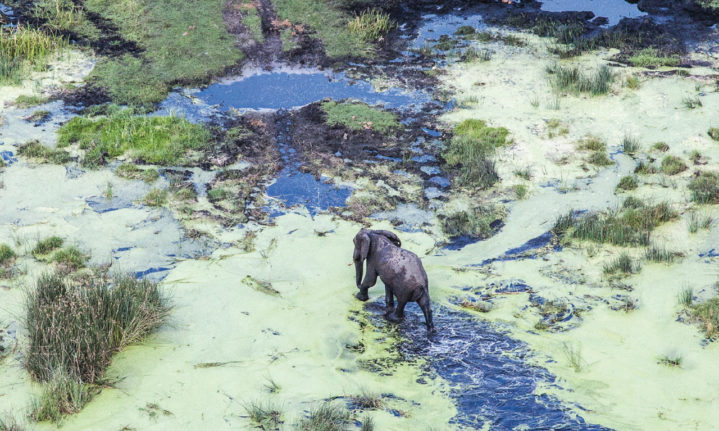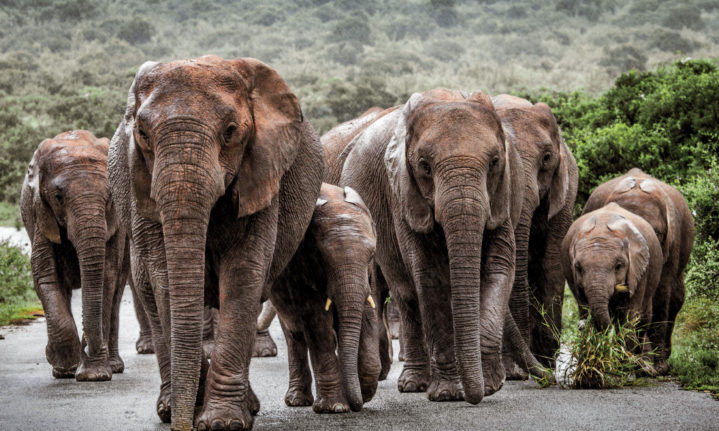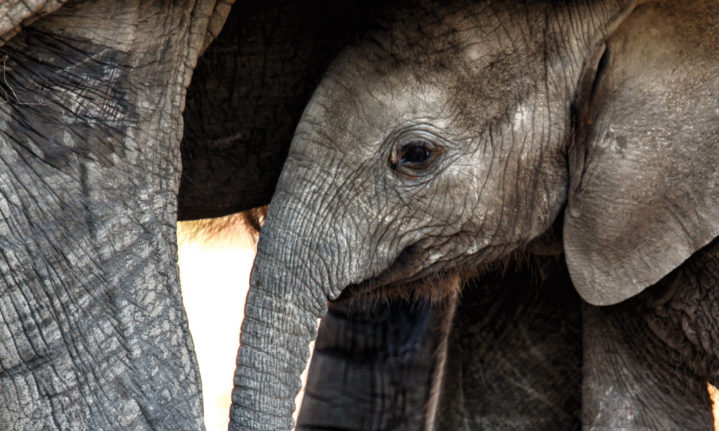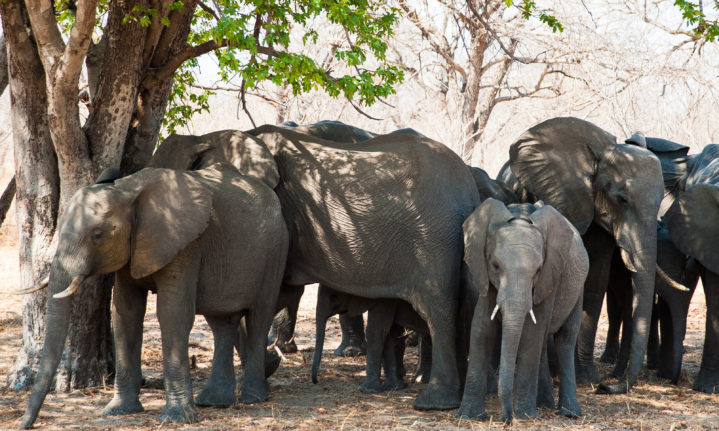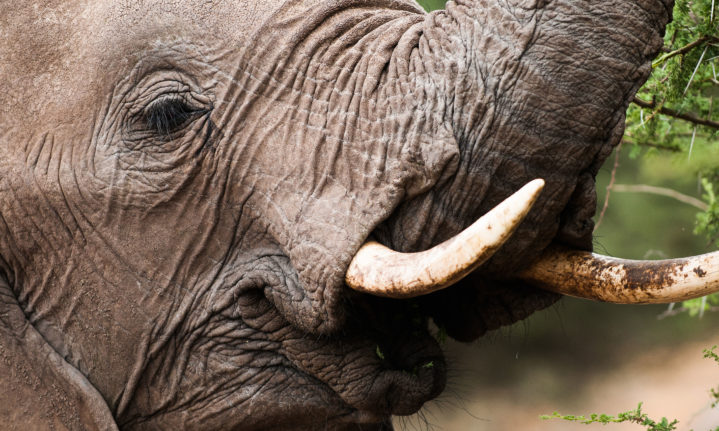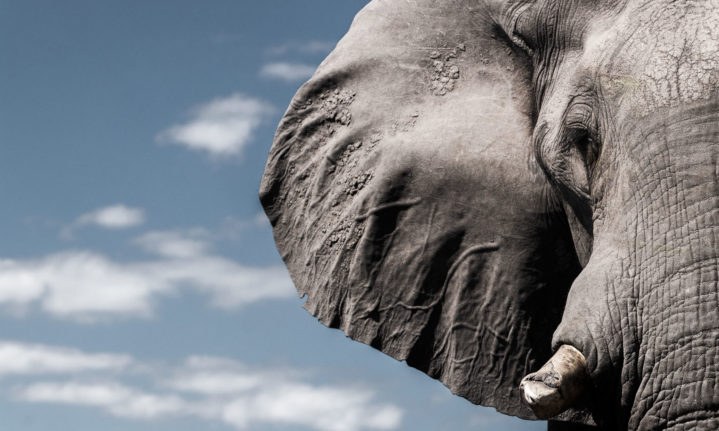The long, thoughtful regard of an elephant, which could either stroke you with its trunk or flatten you, is one of Africa’s greatest spine-chilling moments. You feel it’s intelligence but you have no idea what it’s thinking.
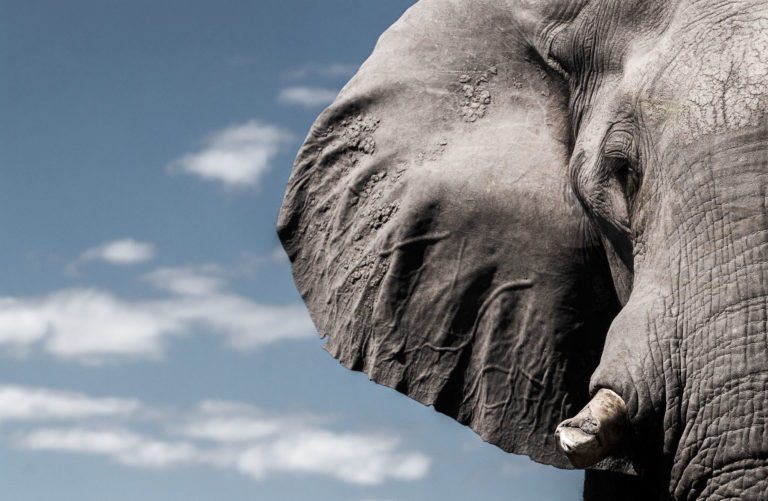
Here are 10 of the best places in Southern Africa to engage with these giants.
1. Tembe Elephant Park, Northern Kwazulu-Natal

You’ll need a 4×4 to self-drive the swamps and sandy roads of this Big Five park that’s also a top birding destination.
Until a few years ago, Tembe had the southern hemisphere’s rock-star elephant with the biggest tusks this side of the equator. Isilo was a venerable 56 years old when he died of natural causes in 2014. His tusks weighed more than 65 kilograms. The 300-square-kilometre park still has some huge tuskers, all pretty chilled around tourists. With elephant families comprising nearly 300 individuals, it’d be impossible not to encounter them on a game drive.
The park was proclaimed in 1983 to protect elephants migrating between southern Mozambique and Maputaland and to manage crop raids. It’s 50 per cent owned and fully run by the local community, which also owns and manages a lodge in the park.
Getting there From Durban, head north on the N2; after Mkuze, turn off to Jozini. The park is 72km further and is well signposted.
Park fees R50 per person + R110 (car).
Stay here Tented suites at Tembe Elephant Park Lodge are from R1,650 per person sharing a night (three night stay), including meals and drives. 0312670144, tembe.co.za There are also self-catering Airbnb options around Jozini.
2. Addo Elephant Park, Eastern Cape

Addo’s dense valley bushveld means taking the road is a much easier commute to waterholes – and they happily share the tarmac with vehicles.
In the early decades of the 20th century, elephants were not welcome in the Addo area and exterminated by government decree. By 1931, there were only 11 left when public distaste at the slaughter convinced the authorities to declare it a national park.
Since then, Addo has become one of the country’s premier elephant conservation and viewing areas. But because of earlier ivory-hunting pressure, the park’s 600 elephants are largely tuskless. They’re now so easy-going, rangers don’t bother to carry firearms.
You’ll see elephants on any of the park drives; Marion Baree waterhole is particularly good for close-up interactions with breeding herds. The waterhole lookout point at Main Camp is floodlit at night and there’s an underground hide for startlingly close encounters.
Getting there The south gate is only 45 minutes’ drive from Port Elizabeth on the N2, or turn off at Motherwell and follow the signs to the main gate.
Park fees R68 per person.
Stay here There are four rest camps in Addo: Main Camp, Nyathi, Spekboom and Matyholweni. Within these is a wide range of accommodation, including two-sleeper safari tents from R830, forest cabins from R930 (sleep four), rondavels overlooking a waterhole from R1,500 (sleep two) and guest houses from R4,610 (sleep six). Camping costs from R280. 0422338600, sanparks.org
3. Kruger National Park, Mpumalanga
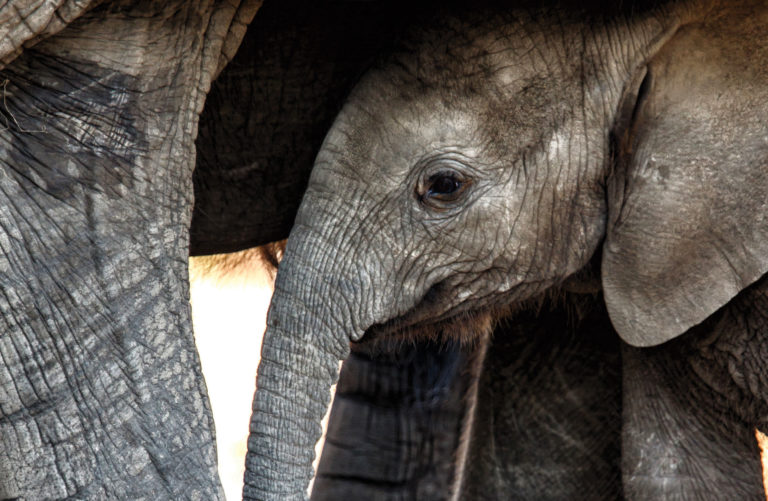
Before young cows in a breeding herd have their own offspring, they will protect and help any calf
in trouble. Related cows also share suckling duties.
In Kruger, if you’re not seeing elephants, you’re not leaving your hut. In the wet season they are more widespread, but in the dry season they spend more time closer to water. So drive the roads close to the main rivers and seasonal rivers that have natural waterholes.
The Crocodile River in the south and the Biyamiti Loop a little further north provide enchanting encounters, as do roads along the Skukuza to Lower Sabie route. North of Satara is a new one-way gravel road that passes a few springs. It’s a fabulous landscape with great elephant sightings.
They are also often spotted from the high-water bridges crossing the Olifants and Letaba rivers as well as from the Olifants River lookout. Further north, there are usually exceptional sightings on the winding roads around Shingwedzi in the dry season, when large numbers of elephants use the Shingwedzi River’s persistent pools.
Getting there There are airports at Phalaborwa, Hoedspruit and Nelspruit (the latter is the only option from Durban or Cape Town). These are also the main feeder towns to the park for self-drivers.
Park fees R82 per person.
Stay here There are 12 main rest camps, five bushveld camps (cottages from R1 150), six satellite camps ( from R295 per person sharing at Tamboti Tented Camp), two overnight hides (from R725 a night) and two bush lodges (from R3,270, sleep up to 12 or 18). Camping is from R285. sanparks.org
4. Kaokoveld, Northwest Namibia
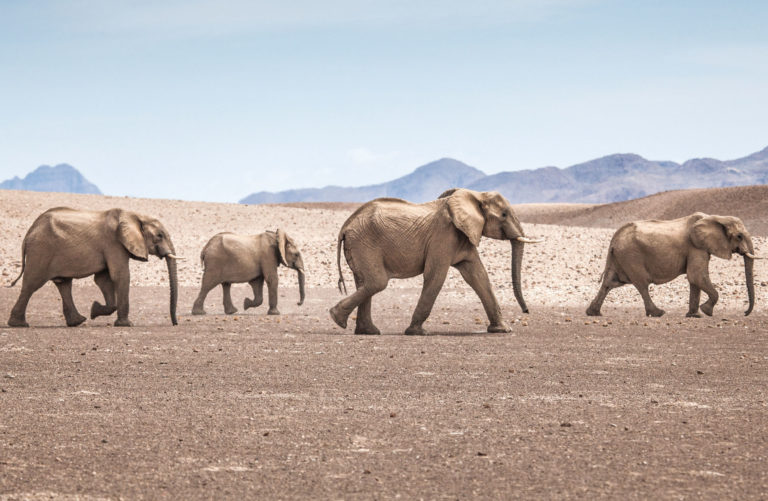
Kaokoveld’s roughly 130 ellies have become ‘neat’ feeders – they don’t knock over trees, strip bark or break branches – and they can go several days without water.
A family of elephants striding across the desert is an eerie sight. They’re like explorers on another planet. But they’ve learned the ways of the Namib and do just fine.
The best place to see them is west of Sesfontein in the Hoanib River. They’re also found from about 40 kilometres east of Purros all the way to the mouth of the Hoarusib River. These are mostly the same herds which move from the Hoanib to the Hoarusib in May/June, then back in October/November, depending on which trees are bearing fruit.
Getting there This is 4×4 country with no compromises. You have to be well equipped and in a party of more than one vehicle. The Kaokoveld/Kunene Region is about eight hours’ drive from Windhoek. Note: going in midsummer is only for the hardy.
Stay here Fort Sesfontein is a hotel in an old German fort. R1,375 per person sharing B&B. It offers a guided drive to see the elephants for R1,060 per person. +26465685034, fort-sesfontein.com
Another option is camping, which is cheap (less than R200). There is the Cameltop community campsite in Sesfontein, and good sites at Warmquelle (the pools here deserve
a visit, ongongo.com) and Khowarib. Purros campsite is magical. There are also plenty of spots to wild camp in the river (check for rain in the wet season).
5. Horseshoe Bend, Zambezi Region (Caprivi), Namibia
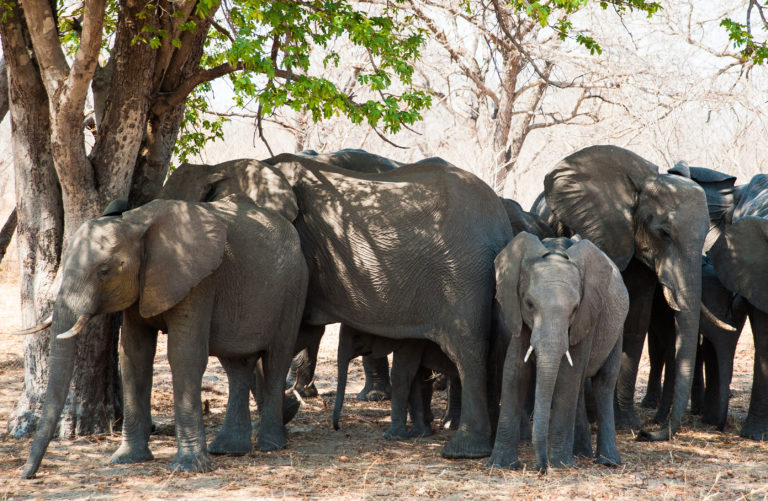
Horseshoe Bend on the Kwando River is a secret place beloved of elephant watchers in the know. It’s an oxbow lake where very large numbers of elephants come to drink simultaneously. Best is to hang out under the jackalberry trees towards sunset and wait for the show.
The Bend is in the 6 100- square-kilometre Bwabwata National Park. Namibia’s newest park began as the Caprivi Game Reserve back in the 1960s, but during the Namibian liberation struggle the area became a restricted SADF security zone and is only now emerging from a grim history of war. And the elephants are back.
Getting there Bwabwata is 900km from Windhoek on the Trans-Caprivi highway (B8). The nearest big town is Rundu, 200km west of the park.
Park fees R30 per person + R10 (car).
Stay here There are several options in the area. A good budget choice is Divundu Guest House, near the entrance to the park (and very near Popa Falls) – thatched bungalows for R475 per person sharing B&B, new on-river rooms R600 per person sharing, camping R95 per person. +26466259031, safarinow.com. More upscale Shametu River Lodge has chalets from R870 per person sharing or luxury tents from R985 per personsharing. Camping is R410 for two. +26461237294, shameturiverlodge.com
6. Etosha Waterholes, Namibia
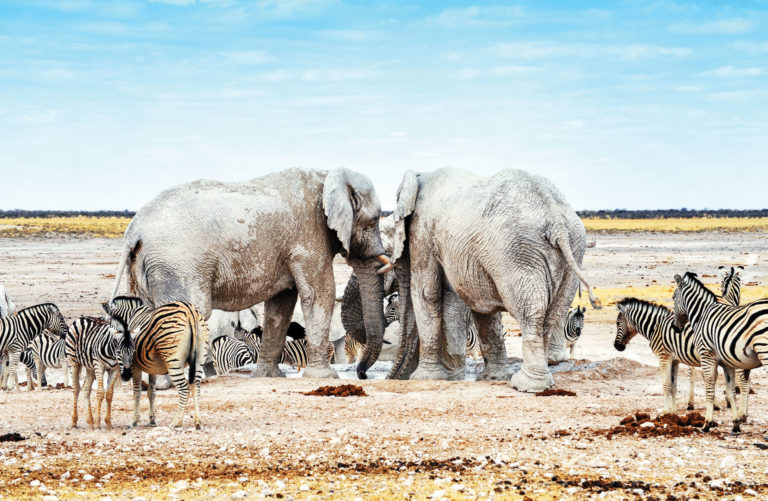
Permanent water spots in Etosha are busier than a sports bar during a rugby test match, with as varied a clientele. And just like crowded bars, size tends to dictate who gets to drink first.
Etosha National Park is one of Africa’s great wildlife-viewing destinations. Instead of trekking around looking for animals, simply hang out at one of the waterholes and they’ll come to you. Olifantsbad, southeast of Okaukuejo, is well named and is much loved by the great grey creatures. Aus, nearby, also produces fabulous sightings.
Moringa waterhole at Halali Camp is another special place favoured by elephants during early mornings and evenings. Perched on a koppie with an amphitheatre-style view over the waterhole, it’s also special for seeing black rhino under evening floodlights. Kalkheuwel near Namutoni is good for breeding herds of elephants, and many other animals besides.
Getting there Etosha is 435km north of Windhoek and the drive takes about six hours on good roads.
Park fees R60 per person + R10 (car).
Stay here There are three rest camps – Namutoni (adjacent to the historical fort), Halali and Okaukuejo – with a range of options: Rooms from R900 per person sharing B&B, bush chalets from R1,000 per person B&B, waterhole chalets at Okaukuejo from R1,500 per person B&B. The new Olifantsrus campsite (maximum eight people) costs R350 per person; other campsites cost R300 per person. The luxury camps, Dolomite and Onkoshi, have chalets from R1,820 per person B&B.
+264612857200, nwr.com.na There are also several private lodges just outside the park.
7. Mana Pools, Zimbabwe
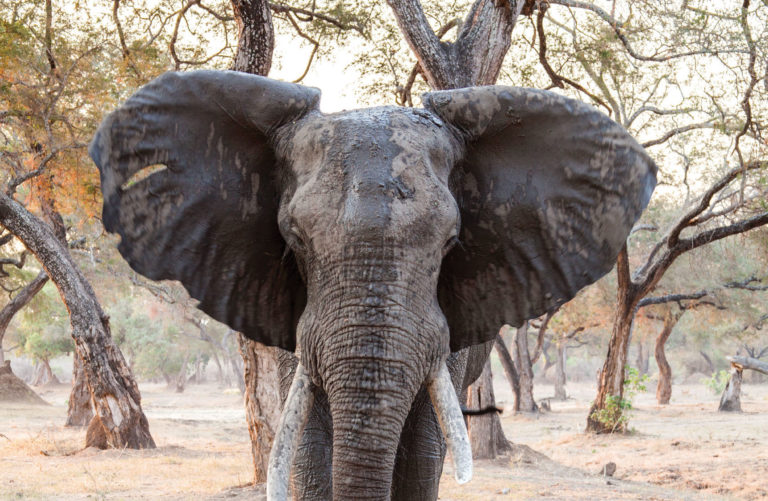
With a 4×4 and a good knowledge of wildlife behaviour, you’ll have animal encounters in Mana Pools like few other places on Earth.
For the thrill and fear of walking around unguided in an unfenced park full of wild animals, Mana Pools on the Zambezi River in northern Zimbabwe is the place. Elephant encounters are certain and frequent. However, they’re relaxed around people and are quite likely to have a long sniff at your tent at night (as are the lions, so be careful).
Getting there Access roads to Mana Pools National Park (270km from Harare) are fine, but you’ll need a 4×4 in the park.
Park fees R295 per person (paid in US dollars), vehicle R147. A walking permit is R220, guided walks cost R370.
Stay here Nyamepi, the main camp, has 30 sites with braai places, flush toilets and hot showers. From R1,035 to R1,700 for up to six people. There are several exclusive campsites (one party only, six people max) around the park – Ndungu, Mucheni, Chitake, BBC, Gwaya and Nkupe – from R1,330 to R2,540.
There are also four tented camps and five self-catering ‘lodges’ (rustic cabins). zimparks.org, but rather book through manapools.com – the $50 fee is worth it.
8. Little Makalolo, Hwange National Park, Zimbabwe
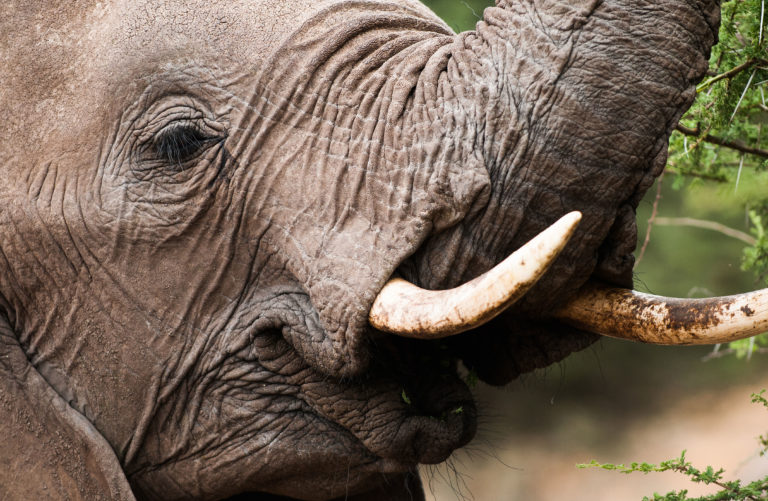
The introduction to this story took place at Little Makalolo, so it holds a special place in my heart. The hide gets you close and personal – especially in the winter months – with hundreds of elephants. It’s in a private concession so no crowds intrude. Besides elephants, there’s a strong possibility of seeing buffalo, rhino, hyena, giraffe and the occasional leopard.
Hanging out there as the sun sinks is one of the continent’s great pleasures. But from pretty much anywhere in Hwange you are ensured of excellent elephant interactions.
Getting there There are good paved roads to Hwange from Bulawayo (340km) and Victoria Falls (100km), and within the park they’re not bad.
Park fees R220 per person + R145 (car).
Stay here Little Makalolo is in the southeastern sector of the park, overlooking a vibrant waterhole. The six luxury safari tents include a family unit. From R6,800 per person sharing, including all meals, two daily safari activities and park fees. 0112575000, wilderness-safaris.com There are campsites and basic bush camps in Hwange at a fraction of the cost. zimparks.org
9. Chobe National Park, Botswana
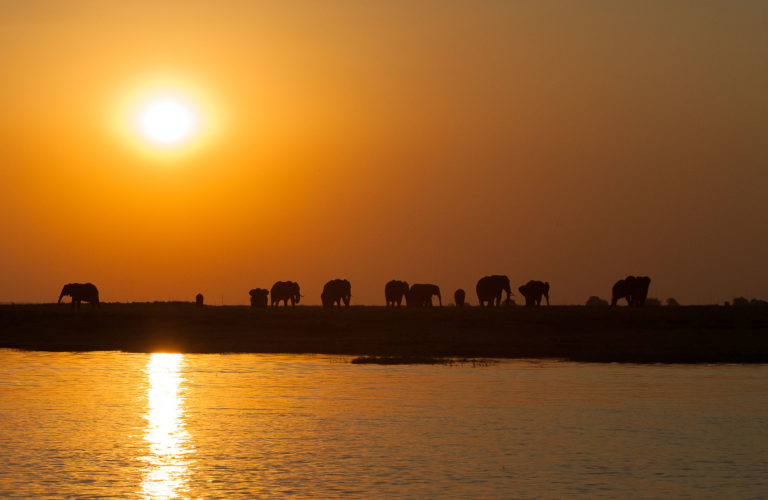
There’s a small bay along the Chobe River favoured by elephants. It’s not on any map (ask a ranger) and it’s hit and miss when the great grey creatures arrive, so park on the beach and wait. The reward for patience is enormous. Both times I’ve been there my vehicle was literally engulfed by elephants. Chobe National Park in Botswana has the highest density of elephants in the world – maybe 120 000 at times – and they’re so chilled one stuck its trunk through my open window and gave me a long, thoughtful sniff.
Getting there Most visitors access the park from Kasane – there is an airport here, and the Sududu Gate is just outside town. A 4×4 is recommended. You’ll also have excellent game encounters on a boat trip down the Chobe River.
Park fees R163 per person + R68 (car).
Stay here The park has three campsites – Ihaha, Savuti and Linyati – with basic facilities. From R240 per site. chobenationalpark.co.za/chobe-camping There are several lodges and hotels in Kasane and outside the park, but most are fairly pricey. chobenationalpark.com There are also Airbnb options.
10. Moremi Game Reserve, Botswana

In this, the dry season, Moremi’s ‘roads’ are a 4×4 challenge; in the wet season many become impassable.
My abiding memory of Moremi is watching a very large elephant in Xakanaxa Camp trying to reach marula fruit. Not quite managing the height, he stepped on a small brown tent thinking, no doubt, it was an anthill. The young couple who owned it watched aghast as the tent imploded. Probably puzzled, the elephant wandered off, trailing their clothesline of soggy washing.
Moremi is hardcore, but it’s one of the most magical wildlife destinations in the world. Paradise Pools in Xakanaxa is not on the regular map (ask at the entrance gate) but it’s a secret elephant playground. Another nearby place for elephants is the Mokotlho community campsites on the Khwai River.
Getting there From Maun and its airport, it’s mostly corrugated or soggy narrow roads (80km to the park gate).
Park fees R150 per person + R65 car.
Stay here There are a few pricey luxe lodges. Camping is the best option, and you need to be completely self-sufficient. Campsites are excellent, with hot showers. About R200 per person.
at Xakanaxa. getaway.co.za/travel-ideas/book-campsites-botswanas-national-parks
Going, going…
There are fewer than 500 000 elephants left in Africa, according to the 2016 Great Elephant Census – well down from the three to five million just a century ago. Human-elephant conflict and poaching seem inevitable and we know who wins those contests. On average, three elephants are being killed every hour in Africa. Add in their forest cousins in Asia, and that number becomes an elephant being shot every 15 minutes. Their future is in our hands.










